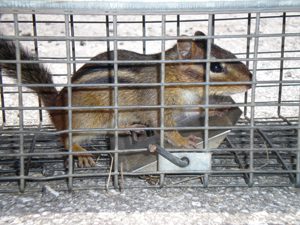Finding Balance Between Urban Wildlife and Humans
Return to Agent Articles.
 The common approach for most nuisances is to get rid of it. The method of elimination for each nuisance may look a little different.
The common approach for most nuisances is to get rid of it. The method of elimination for each nuisance may look a little different.
Some pests are able to be dealt with by cultural practices — making a physical change that eliminates the pest. Have a pesky raccoon visiting the neighborhood? Eliminate access to garbage containers and keep pet food indoors. Is there a squirrel getting to the bird feeder and eating all of the bird seed? Install a feeder that prevents squirrels from gaining access to the seed.
Live trapping
 But what about the pests that can’t be blocked out or out-maneuvered by some clever contraption? Some are able to be trapped and released elsewhere with limited success. Squirrels can find their way back to a home territory if released less than 10 miles away. And many wildlife specialists agree that releasing an animal away from its home territory can be more inhumane than eliminating it on the spot. When an animal is released into a new territory, it no longer knows where sources of food and water are and will have to learn what predators are in the area.
But what about the pests that can’t be blocked out or out-maneuvered by some clever contraption? Some are able to be trapped and released elsewhere with limited success. Squirrels can find their way back to a home territory if released less than 10 miles away. And many wildlife specialists agree that releasing an animal away from its home territory can be more inhumane than eliminating it on the spot. When an animal is released into a new territory, it no longer knows where sources of food and water are and will have to learn what predators are in the area.
Using chemicals or poisons
 Another method of control is utilizing chemicals. This is the use of chemicals to either deter or eliminate nuisance pests. Examples of this are the use of poison baits for rodents or insecticidal sprays for insects. At first, these seem like the perfect control — a targeted approach that should only impact what we are wanting to get rid of. However, the decision to use a chemical should never be taken lightly.
Another method of control is utilizing chemicals. This is the use of chemicals to either deter or eliminate nuisance pests. Examples of this are the use of poison baits for rodents or insecticidal sprays for insects. At first, these seem like the perfect control — a targeted approach that should only impact what we are wanting to get rid of. However, the decision to use a chemical should never be taken lightly.
The rodents that eat a poison bait could then be prey for a hawk, or even a neighborhood cat. The dose of poison that the rodent ate may, or may not, be enough to also impact the predator. Insecticides for yard use can help keep our lawns and yards free from ticks and mosquitoes, but the insecticides used can usually impact other beneficial insects as well. Ladybugs, green lacewings, butterflies and bees are all insects that bring great benefit to our green spaces. These beneficial insects can be impacted and even eliminated by the broad spectrum insecticides used to create an environment free from nuisance pests.
Finding a balance between man and nature
Finding a good balance between wildlife habitat and safe, human living space can be difficult. I’m a firm believer that balance can be found and maintained with a little understanding and work. When making your decisions about how to handle a nuisance pest, think about what all could be impacted by your management practice. Are those outcomes acceptable to you, or is there another strategy that could be used? Every critter has a role to play, and learning how to work with those roles, instead of against them, can be difficult but definitely worth it.
Other Resources
Contact Us
Amy Keigher
Natural Resources Agent
amy.keigher@jocogov.org
913-715-7000